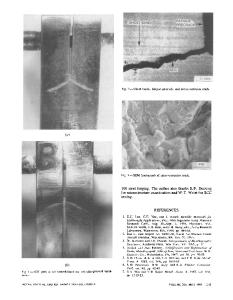Transmission electron microscopy examination of hardening and toughening phenomena in Aermet 100
- PDF / 4,435,800 Bytes
- 13 Pages / 597 x 774 pts Page_size
- 55 Downloads / 303 Views
I.
INTRODUCTION
H I G H performance applications require materials with ultrahigh strength capability with good fracture toughness and fatigue resistance. Therefore, over the past several decades, there has been extensive interest in the structure and mechanical properties of secondary hardening ultrahigh strength steels. The initial studies during the sixties and seventies focused on the microstructure and mechanical properties of simple Fe-M-C systems where M would consist of one or more elements (such as Mo, W, V, Cr, etc.) which are known to cause secondary hardening.J1 13] Other investigations disclosed that cobalt additions to Fe-Ni-Mo-C steels resulted in an increase in (1) the Ms temperature, (2) the activity coefficient of carbon resulting in enhanced diffusion, and (3) solid solution strengthening. 1~4-~7]The microstructure of steels containing cobalt was shown to exhibit a higher rate of M2C carbide nucleation, increased particle refinement, and a decreased propensity to austenite reversion upon tempering. The precipitation of the fine M2C-type carbides was attributed to the delayed recovery of the dislocation substructure of the martensite in Fe-Mo-C steels containing cobalt.lJ4'~6.~71 The subsequent work by Speich established the basis for the new generation of alloy steels containing nickel and cobalt where the combination of high strength and toughness was emphasized. Ij6"]7j These concepts led to the development of AF 1410 steel and other ultrahigh strength steels with superior toughness by Machmeier and co-workers, t~8.~91 The mechanisms of strengthening, with particular emphasis on carbide composition, crystal structure, and coarsening in these steels, were extensively studied by Olson and other workers, t2~176 Based on improved melting techniques and some alloy modifications, Schmidt and Hemphill recently developed a new high performance steel, Aermet 100, which RAGHAVEN AYER is with STEM, Inc., Woodbridge, CT 06525. P.M. MACHME1ER, Manager-Materials and Process Engineering, is with Snap-on Tools Corp., Kenosha, WI 5314l. Manuscript submitted January 6, 1993. METALLURGICAL TRANSACTIONS A
exhibited even higher strength and toughness compared to AF 1410.[31.32] However, a fundamental understanding of the critical microstructural features which provided the high strength and toughness in this steel is still not clear. Therefore, the present study was undertaken to conduct a detailed microstructural analysis of Aermet 100 steel to understand the variations in strength and toughness during tempering. Transmission electron microscopy (TEM) and X-ray diffraction were used to characterize the strengthening carbides and austenite, and X-ray line broadening analysis was performed to determine the onset of recovery in the martensite. An overview of the study was reported in a recent symposium, i33] and the details of the experimental results are described in this article.
II.
EXPERIMENTAL PROCEDURE
The composition of the steel investigated in this study is listed in Table I. The steel was V I M / V A
Data Loading...











